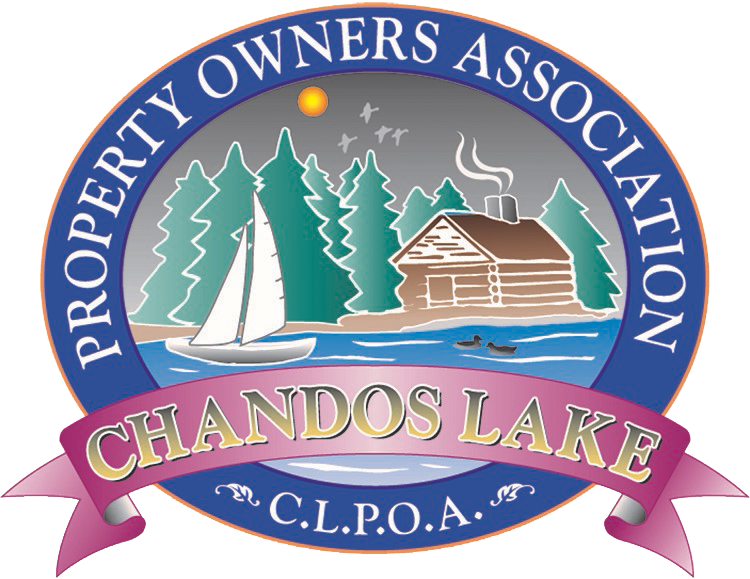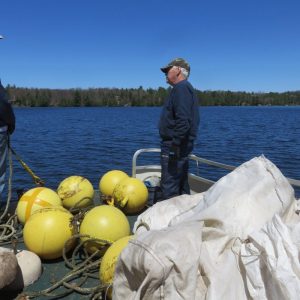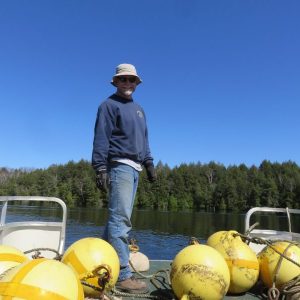Chandos Lake has its share of rocks, boulders, shoals and bedrock that represent significant hazards to most kinds of watercraft. Interestingly, most of these hazards are not visible but are submerged by the normally high-water level of our lake in the early spring. Boating at that time of the year can be particularly dangerous for operators who are not familiar with the lake.
Spring
Every spring – usually just before the May 24 weekend – a committed group of CLPOA Volunteers collect the anchors and yellow balls from each of three winter storage locations around Chandos Lake. Each anchor weighs in excess of 30 kg (65 lbs) and the balls from each storage location take up most of the space on the CLPOA Pontoon boat. The marker lines are connected to the anchors with metal shackles and using a GPS to identify the location of the marker they are dropped off of the front of the boat at each of the over 110 locations.
Summer
During the busy summer months, volunteers pick up errant or damaged markers thanks to tips received by the CLPOA. New markers are purchased to replace those lost or too heavily damaged to remain in service. Cable and other supplies to secure the marker to the shoal are also purchased.
Fall
Each October – usually starting on the Monday of the Thanksgiving weekend – the process is reversed. The volunteers manually secure the ball and then lift up the anchor into the boat one at a time. The anchors are disconnected from the rope attached to the ball and the balls and ropes are placed into storage bags. Once the boat is full of anchors and bags of balls, the boat is manually unloaded at each of three winter storage locations.
It is critical that boaters realize that the markers are NOT navigational buoys. Instead, the markers call attention to some lake hazards. All boaters should safely operate their water crafts, staying a minimum of 60 metres (200 feet) away from the markers and never go between any of the markers or between any of the markers and shore. And, while some of the markers have reflective surfaces, they are not suitable as night or low light navigational aids and extra care must be taken if one chooses to boat during these times.
FAQs
Q: Why are the Lake Hazard Markers only Yellow in colour?
A: According to Transport Canada, the government agency in charge of Navigational Buoys, yellow Buoys mark danger zones. (Transport Canada – Buoys and Markers).
While Chandos Lake had both Red and Yellow Buoys on the lake many years ago, we have now adjusted our practices to the government standard, and only have Yellow Buoys.
Q: If we want a new buoy, or the current one is missing or wrongly placed, what do we do ?
A: We ask for everyone’s help on this, as no one knows a rock shoal/outcropping better than the cottagers closest to it. So if things adjust, or if we miss our mark in placement, or a marker comes loose, feel free to adjust them yourself if you can do it safely. Or email info@clpoa.ca.
Regarding new Buoys – while we do our best to mark the most hazardous areas, it is not realistic for us to be able to mark everything, especially in areas that are close to shore or have little boat traffic. However, if you feel that one is needed, please contact us and we’ll review the area in question.
Q: May private citizens/cottagers mark hazards?
A: Yes, citizens may mark anything with appropriate private buoys, which must meet the Private Buoy Regulations for requirements of size, shape, colour, and symbols. Transport Canada gets involved when private Aids are placed in contravention to the Private Buoy Regulations and can issue fines and/or order removal if private buoys do not comply. (Private Markers (Buoys) Update 2010 – FOCA Federation of Ontario Cottagers’ Associations)







